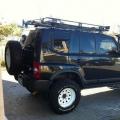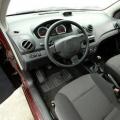Somehow a long time ago I came across a diagram of a stepper motor driver on an LB11880 microcircuit, but since I did not have such a microcircuit, and there were several motors lying around, I postponed an interesting project with starting a motor on the back burner. Time passed, and now there are no problems with the development of China with details, so I ordered an MS, and decided to assemble and test the connection of high-speed motors from the HDD. The driver circuit is taken as standard:
Motor driver circuit
The following is a short description of the article, read the full one. The motor that drives the spindle of the hard disk drive (or CD / DVD-ROM) is a conventional synchronous three-phase DC motor. The industry produces ready-made single-chip control drivers, which, moreover, do not require rotor position sensors, because the motor windings act as such sensors. Three-phase DC motor control ICs, which do not require additional sensors, are TDA5140; TDA5141; TDA5142; TDA5144; TDA5145 and of course LB11880.

The engine connected according to the indicated schemes will accelerate until either the limit on the VCO generation frequency of the microcircuit, which is determined by the ratings of the capacitor connected to pin 27, is reached (the lower its capacity, the higher the frequency), or the engine will not be destroyed mechanically. Do not reduce the capacity of the capacitor connected to pin 27 too much, as this can make it difficult to start the motor. The rotation speed is adjusted by changing the voltage at pin 2 of the microcircuit, respectively: Vpit - maximum speed; 0 - the engine is stopped. There is also a seal from the author, but I spread my version as more compact.

Later, the LB11880 microcircuits I ordered came, sealed them into two ready-made shawls and tested one of them. Everything works great: the speed is regulated by a variable, it is difficult to determine the rpm, but I think there are up to 10,000 for sure, since the engine hums decently.

In general, a start has been made, I will think about where to apply it. There is an idea to make from it the same grinding disc as the author's. And now I tested it on a piece of plastic, made a type of fan, it blows just brutally, even though the photo does not even show how it is spinning.

It is possible to raise the speed above 20,000 by switching the capacitors of the C10 capacitor and supplying power to the MC up to 18 V (18.5 V limit). At this voltage, my motor whistled thoroughly! Here is a video with 12 volts:
HDD motor connection video
I also connected the engine from the CD, drove it with a power supply of 18 V, because there are balls inside my, it accelerates so that everything jumps around! It's a pity not to track the speed, but judging by the sound, it is very large, up to a subtle whistle. Where to apply such speeds, that's the question? A mini grinder, a tabletop drill, a grinding machine come to mind ... There are many applications - think for yourself. Collect, test, share your impressions. There are many reviews on the Internet using these engines in interesting homemade designs. I saw a video on the Internet, there are kulibins with these motors, pumps are made, super fans, sharpeners, you can figure out where to apply such speeds, the motor here accelerates over 27,000 rpm. I was with you Igoran.
. The topic is undoubtedly interesting, especially for novice radio "tormentors", but in my opinion it is far from fully disclosed. Nological conclusion, namely which scheme was used by a much respected, TwIsTeRfor my decision, proposed by (my colleague in journalistic work)Sanyaav on М / С TDA5145, MK or some other. With this article, I want to supplement some of the gaps in the forum and tell, in my opinion, about a completely decent, even by modern standards, and an old microcircuitLB11880. And so let's get started and start with general information, what is an engine from HDD, CD-ROM, DVD-ROMThe motor that rotates the hard drive spindle (or CD / DVD-ROM) is a synchronous three-phase DC motor.
You can spin such a motor by connecting it to three floor bridge stages, which are controlled by a three-phase generator, the frequency of which, when turned on, is very low, and then gradually increases to the nominal. This is not the best solution to the problem, such a circuit has no feedback, and therefore the generator frequency will increase in the hope that the engine has time to pick up speed, even if in fact its shaft is stationary. The creation of a feedback circuit would require the use of rotor position sensors and several IC cases, not counting the output transistors. CD / DVD-ROM already contain hall sensors, according to the signals of which it is possible to determine the position of the engine rotor, but sometimes the exact position is not important at all and you do not want to waste "extra wires".
Fortunately, the industry is releasing off-the-shelf single-chip control drivers that also do not require rotor position sensors, rather like the motor windings.Control microcircuits for three-phase DC motors, which do not require additional sensors (the sensors are the motor windings themselves):TDA5140; TDA5141; TDA5142; TDA5144; TDA5145 and of course LB11880. (There are some others, but at another time.)
Schematic diagram of connecting the motor to the LB11880 microcircuit.
Initially, this microcircuit is designed to control the motor of BVG VCRs, in the key stages it has bipolar transistors and not MOSFETs.In my designs, I used this particular microcircuit, firstly, it was available in the nearest store, and secondly, its cost was lower (although not by much) than other microcircuits from the above list.
Actually, the engine switching circuit:

If your engine suddenly has not 3 but 4 terminals, then it should be connected according to the diagram:

And one more more illustrative diagram, adapted for use in a car.
Some additional information about LB11880 and more
The motor connected according to the indicated schemes will accelerate until either the limit on the VCO generation frequency of the microcircuit, which is determined by the ratings of the capacitor connected to pin 27, is reached (the smaller its capacity, the higher the frequency), or the motor will not be destroyed mechanically.Do not reduce the capacity of the capacitor connected to pin 27 too much, as this can make it difficult to start the motor.
How to adjust the rotation speed?
The rotation speed is adjusted by changing the voltage at pin 2 of the microcircuit, respectively: Vpit - maximum speed; 0 - the engine is stopped.
However, it should be noted that it will not be possible to smoothly adjust the frequency simply by using a variable resistor, since the adjustment is not linear and occurs within a smaller range than Vpit - 0, therefore the best option would be to connect a capacitor to this output through a resistor, for example, from a microcontroller PWM signal or PWM regulator on the world famous timerNE555 (there are plenty of such schemes in the internet)
To determine the current rotational speed, use pin 8 of the microcircuit, on which pulses are present when the motor shaft rotates, 3 pulses per 1 shaft revolution.
How to set the maximum current in the windings?
It is known that three-phase DC motors consume a significant current outside their operating modes (when feeding their windings with pulses of low frequency).Resistor R1 is used to set the maximum current in this circuit.As soon as the voltage drop across R1 and therefore at pin 20 becomes more than 0.95 volts, the output driver of the microcircuit interrupts the pulse.When choosing the value of R1, keep in mind that for this microcircuit the maximum current is no more than 1.2 amperes, nominal 0.4 amperes.
Parameters of the LB11880 chip
Output stage supply voltage (pin 21): 8 ... 13 volts (maximum 14.5);
Core supply voltage (pin 3): 4 ... 6 volts (maximum 7);
Maximum power dissipated by the microcircuit: 2.8 watts;
Operating temperature range: -20 ... +75 degrees.

This disk (though when there were no copper bolts on it yet), a seemingly small and stunted engine from an old 40GB hard drive, designed for 7200 rpm (RPM), managed to accelerate to about 15000 ... 17000 rpm, if do not limit its speed. So the area of \u200b\u200bapplication of engines from flooded hard drives, I think, is very extensive. A sharpener / drill / grinder of course cannot be done, do not even think, but without a special load, engines are capable of much.
F
download file for self-assembly
GOOD LUCK !!
When using old HDD drives for application purposes, sometimes there is a problem with the spindle motor stopping after a while after starting. They have such a "trick" - if no signals are received from the head block to the controller microcircuit, then it prohibits the driver microcircuit from rotating the engine. Using several drive models as an example, let's try to figure out how to fix this.
It all started with the fact that they brought several old hard drives ( fig. 1) and said that here workers are mixed with the "killed", if you want - choose, if you don't want - do what you want. But if you can figure out how to use them as a small emery for dressing a tool, tell me. Well, now - I'm telling ...
First HDD - Quantum of the Fireball TM family with the TDA5147AK drive microcircuit ( fig. 2). Let's see what he is.

The top cover is secured with 4 screws at the corners and one screw and nut located on top, under the stickers. After removing the cover, you can see the hard disk itself, the reading heads and the magnetic head position control system ( fig. 3). We disconnect the cable, unscrew the magnetic system (here you need a specially sharpened hex key "asterisk"). If desired, the disc can also be removed by unscrewing the three screws on the motor spindle (a hexagon is also needed).

Now we put the cover back in place so that you can turn the HDD over for experiments with electronics and supply +5 V and + 12V voltages to the power connector. The motor accelerates, runs for about 30 seconds, and then stops (there is a green LED on the PCB - it lights up when the motor is rotating and flashes when it stops).
The datasheet for the TDA5147K microcircuit is easily found in the network, but it was not possible to understand the rotation enable / disable signal. When the POR signals were “pulled” to the power buses, the desired response was not achieved, but when viewing the signals with an oscilloscope, it turned out that when the probe touches the 7th pin of the TDA5147AK microcircuit, it is reset and the engine restarts. Thus, having assembled the simplest generator of short pulses ( fig. 4, bottom photo) with a period of several seconds (or tens of seconds), you can make the engine rotate more or less constantly. The resulting pauses in power supply last about 0.5 seconds and this is not critical if the motor is used with a small load on the shaft, but in other cases it may not be acceptable. Therefore, although the method is effective, it is not entirely correct. And it failed to start "correctly".

Next HDD - Quantum of the Trailblazer family (fig. 5).

When the supply voltages are applied, the drive does not show any signs of life and the 14-107540-03 microcircuit begins to warm up on the electronics board. A bulge is noticeable in the middle of the microcircuit case ( fig. 6), which indicates its apparent inoperability. It's a shame, but not scary.

We look at the motor rotation control microcircuit ( fig. 7) - HA13555. It does not heat up when power is applied and there is no visible damage on it. The tester's dialing of the “strapping” elements did not reveal anything special - all that remains is to deal with the “switching on” scheme.

Search engines do not find a datasheet for it, but there is a description on HA13561F. It is made in the same case, it matches the power supply legs and the "output" terminals with the HA13555 (the latter has diodes soldered to the motor supply conductors - protection against back-EMF). Let's try to determine the necessary control outputs. From the datasheet on HA13561F ( fig. 8) it follows that a 5 MHz clock frequency with TTL logic level should be applied to pin 42 (CLOCK) and that the signal to enable the engine to start is a high level at pin 44 (SPNENAB).

Since the 14-107540-03 microcircuit is inoperative, we cut off the +5 V power from it and from all other microcircuits, except for the HA13555 ( fig. 9). With a tester, we check the correctness of the "cuts" by the absence of connections.
In the bottom photo figure 9 red dots show the places where the +5 V voltage is soldered for the HA13555 and the pull-up resistor of its 44 pins. If the resistor from pin 45 is removed from its native place (this is R105 by figure 8) and put it vertically with some inclination to the microcircuit, then an additional resistor for pulling up to the "plus" of pin 44 can be soldered to the via and to the hanging terminal of the first resistor ( fig. 10) and then +5 V power can be supplied to the place of their connection.

On the back of the board, cut the tracks as shown in figure 11... These are "former" signals coming from the burnt out microcircuit 14-107540-03 and the old "pull-up" of the resistor R105.

It is possible to organize the supply of "new" clock signals to pin 42 (CLOCK) using an additional external generator, assembled on any suitable microcircuit. In this case, K555LN1 was used and the resulting circuit is shown in figure 12.

After the MGTF wire passes the +5 V supply voltage directly from the connector to terminal 36 (Vss) and other required connections ( fig. 13), the drive starts and runs non-stop. Naturally, if the 14-107540-03 microcircuit was in good order, the whole revision would consist only in "hauling" the 44th pin to the +5 V bus.

On this "screw" its performance was tested at other clock frequencies. The signal was supplied from an external square-wave generator and the minimum frequency with which the drive worked steadily was 2.4 MHz. At lower frequencies, acceleration and stopping occurred cyclically. The maximum frequency is about 7.6 MHz; with its further increase, the number of revolutions remained the same.
The number of revolutions also depends on the voltage level at pin 41 (CNTSEL). There is a table in the datasheet for the HA13561F chip and it corresponds to the values \u200b\u200bobtained from the HA13555. As a result of all the manipulations, it was possible to obtain the minimum engine speed of about 1800 rpm, the maximum - 6864 rpm. The control was carried out using a program, an optocoupler with an amplifier, and a piece of electrical tape glued to the disk so that when the disk rotated, it overlapped the optocoupler window (the pulse repetition rate was determined in the spectrum analyzer window and then multiplied by 60).
Third drive - "SAMSUNG WN310820A".
When power is applied, the driver chip - HA13561 starts to get very hot, the motor does not rotate. A bulge is noticeable on the microcircuit case ( fig. 14), as in the previous case. It will not be possible to conduct any experiments, but you can try to power the engine from a board with a HA13555 microcircuit. Long thin conductors were soldered to the engine cable and to the output pins of the electronics board connector - everything started and worked without problems. If the HA13561 were intact, the revision for the launch would be the same as for the Quantum Trailblazer (pin 44 to the +5 V rail).

Fourth drive - Quantum of the Fireball SE family with an AN8426FBP drive IC ( fig. 15).

If you disconnect the head unit cable and apply power to the HDD, the engine picks up speed and, naturally, stops after a while. The datasheet for the AN8426FBP microcircuit is on the network and you can figure out from it that pin 44 (SIPWM) ( fig. 16). And if you now cut the track from the 14-108417-02 microcircuit and "pull" pin 44 through a 4.7 kΩ resistor to the +5 V bus, then the engine will not stop.

And finally, going back a little, the waveforms at the W and V pins of the HA13555 microcircuit were removed with respect to the common wire ( fig. 17).

The simplest application of the old HDD is a small emery cloth for dressing drills, knives, screwdrivers ( fig. 18). To do this, it is enough to glue sandpaper on the magnetic disk. If the "screw" was with several "pancakes", then you can make removable discs of different grain size. And here it would be nice to be able to switch the rotation speed of the spindle motor, since at a large number of revolutions it is very easy to overheat the sharpened surface.

Emery is certainly not the only use for an old HDD. The network easily finds designs of vacuum cleaners and even an apparatus for making cotton candy ...
In addition to the text, there are the mentioned datasheets and files of printed circuit boards of external pulse generators in the format of the 5th version of the program (view from the printing side, microcircuits are installed as smd, i.e. without drilling holes).
Andrey Goltsov, r9o-11, Iskitim, April 2018.
List of radioelements
| Designation | A type | Denomination | amount | Note | Score | My notebook | |
|---|---|---|---|---|---|---|---|
| To figure №4 | |||||||
| DD1 | Chip | K561LN2 | 1 | Into notepad | |||
| R1, R2 | Resistor | 470 k Ohm | 2 | smd 0805 | Into notepad | ||
| R4 | Resistor | 10 kΩ | 1 | smd 0805 | |||




